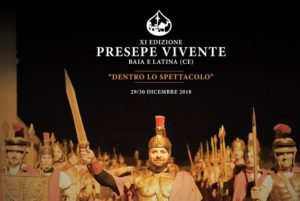
The Living and Itinerant Christmas Crib of Baia and Latina
Faithful to the origins and, according to tradition from the will of St. Francis to revive in a natural setting the birth of Bethlehem with real characters: shepherds, peasants, craftsmen, friars, and nobles all involved in the re-enactment that took place at Greccio the night of Christmas of the year 1223. Greccio (small hill town in the province of Rieti, Lazio Region), Baia and Latina, a borgo ( village) in the Campania Region ( Naples Province) adopted St. Francis heritage by celebrating the event with a plus: “the Living-Itinerant Christmas Crib” since many years ago.
The organizational burden weighs on a permanent Committee made up of local young people, who voluntarily lend themselves to the promotion of the territory, its culture and traditions, and counts on 400 walk-on actors including an army of 40 Roman soldiers, led by a centurion, flanked by soldiers on horseback.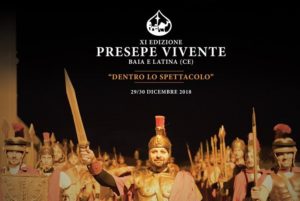
The two-kilometer-long procession moves slowly and festively through the village reconstructed as the ancient Bethlehem, with housing and characters of the era. The procession follows an itinerary designed to highlight 71 posts where craftsmen, products manufacturers and sellers, shepherds and more, are seen engaged in their everyday activities, including the old days “ladies house of pleasure”. Most of the artisan activities still exist to this day.
Sounds of tambourine, bagpipe, accordion and smells of cooking contribute to making the event joyful around every corner. Hostarias are open also to the visitors, who integrate to the procession, to join for a drink of wine or visit the places where old mums work on the production of cheese, filtering honey etc. The absolute new inclusion of this edition will be the presence of artists: “fire-eaters” and “gigglers” plus a pictorial exhibition of local artists on the village’s road.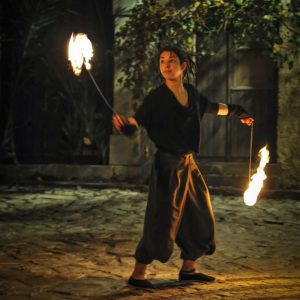
The inhabitants and visitors do follow the Holy Family to the cave.
The annual itinerant representation at Baia and Latina means not only highlighting the hidden or neglected corners of the country but also enhancing crafts, arts and local traditions that have otherwise been lost or endangered.
The visitors attending the event are invited to interact with the various stage reconstructions and with the characters in ancient costumes that animate them, eventually becoming an integral part of the surrounding environment by visiting the shops, taverns, private houses, bakeries and other places to admire the work done by the artisans or the reconstruction of the domestic life of poor but genuine people, and taste some of the typical local products (often faithful to ancient recipes) prepared before their eyes.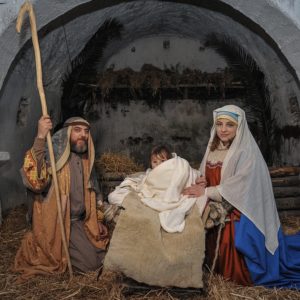
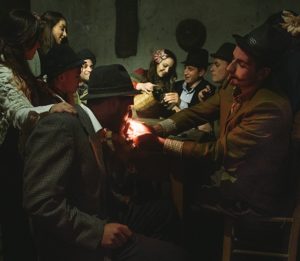
The imposing and original representation, different from all living nativity scenes, with the participation of the villagers who follow the donkey with St. Joseph and Mary in their entrance to Bethlehem, the unique show takes place in the medieval village of Baia capital where the environment has remained unchanged for some centuries.
The representation of the historical-artistic-cultural event, unique in its kind, develops an interest in the national panorama. The objective is also to promote knowledge and enhancement of unused or underused
resources of the Campania Region. A strategic celebration that highlights the development of the small village through the most ancient history that everyone in the world knows: “The birthplace of Jesus.”
Info: Baia e Latina is an Italian town of 2.158 inhabitants in the province of Caserta in the Campania region ( Naples is the capital of the province). It has its roots in an ancient era, which recalls the arrival of the Etruscans, the Samnites, and finally the Romans who left important testimonies of their presence in this area.
The event takes place on 29 and 30 December from 18 to 22.30. In the course of the two evenings, food stands will be set up, with tastings of typical local food and drinks, and a small market for souvenirs.
History of the Italian Nativity
From the fourteenth century, the Nativity is entrusted to the figurative inspiration of the most famous artists who engage in frescoes, paintings, sculptures, ceramics, silver, ivories and stained glass that embellish churches and mansions of nobility or wealthy patrons of the whole of Europe. Among the artists emerge the names of Giotto, Filippo Lippi, Piero Della Francesca, Perugino, Dürer, Rembrandt, Poussin, Zurbaran, Murillo, Correggio, Rubens, and many more.
In the first example of an inanimate nativity scene until the mid-1400s, the artists modeled wooden or terracotta statues in front of a painted backdrop reproducing a landscape that served as background to the Nativity scene displayed inside the churches during the Christmas period.
With the spread in the kingdom of Naples by Charles the Third of the Bourbon dynasty, and in the rest of the Italian states, in the 17th and 18th centuries, Neapolitan artists gave the sacred representation a naturalistic imprint inserting the Nativity in the Campania landscape reconstructed in glimpses of life that see characters of the nobility, the bourgeoisie and the people represented in their daily occupations or in moments of leisure: in taverns to feast or engaged in dances and serenades.
Since last century, the tradition of the Crib gradually gives way to the fashion of the tree decorated with lights and religious feelings blend with the commercial ones, an undeniable temptation proposed by the markets born at the site of the Christmas celebrations, recalling the Biblical note of the “Merchants at the Temple”.
Only churches and small communities such as the Villages maintain today the tradition and escalate to position themselves in the competition rankings: a sin of vanity, not exactly in line with the characteristics of the religious celebration.
